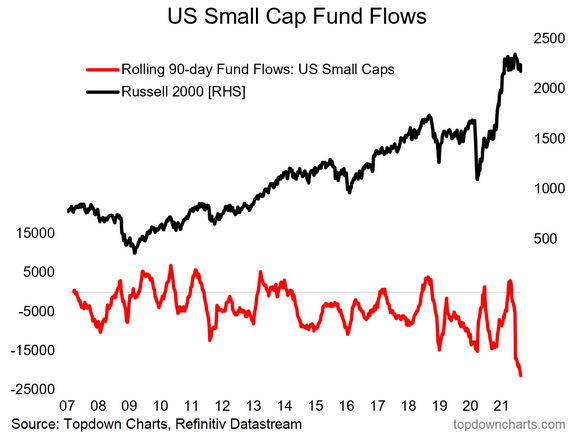This article was originally published at TopDown Charts
US small caps experienced record outflows and a surge in bearish speculative positioning; these contrarian indicators make us lean bullish
Forward valuations are favorable for the S&P Small Cap 600 versus the S&P 500
Investors must pay close attention to changes in the macro environment, given the linkages with bond yields and the sectoral differences.
The ongoing correction in small caps is well-noted in the financial blogosphere. The Russell 2000’s trading range since February has been a choppy mess as technicians stand by to pounce on a breakdown or breakout. We took a deeper dive in this edition of the Weekly Macro Themes report.
Recent Weakness After a Hot Start
Small caps were strong out of the gate in 2021 as the risk-on, high beta narrative continued after jumpstarting in early November of last year. By mid-March, small caps were ahead of large caps by about 14% before mega caps regained leadership. After several months of consolidation and relative weakness, is now the time for the little guys to show their muster? We think there’s a chance, for a few reasons.
Positioning and Flows
First, speculative positioning has collapsed according to the CFTC Commitment of Traders report. It seems traders have had enough of the Russell 2000’s frustrating price-action. The CoT data is the most bearish since early 2019, near the bottom end of its range dating back to 2009. Moreover, investors are pulling funds from the Russell 2000—fund flows on a 90-day rolling basis are at record lows (see chart). These are extreme (and contrarian) sentiment readings that you might expect at bear market bottoms.
Featured Chart from our Weekly Macro Themes Report: Record Russell 2000 Outflows

Relative Valuation Reset
On valuation, it’s more of a mixed picture. The S&P 600 Small Cap Index sports a PE10 in the upper 30s which matches that of the S&P 500. On a forward-looking basis, however, the Russell 2000 is more than 1 standard deviation cheaper than SPX. In the last 20 years, it was only at the depths of the COVID crash when small caps were relatively less expensive. One more relative indicator—the S&P 600’s market cap as a percent of the S&P 1500 (total US market) dropped back near 2.5%, which is at the low-end of its 50-year range (from which it bottomed in 2000).
The Catalysts
So what’s it going to take for US small caps to get back their mojo? The macro situation has to fall to rise into place! First, an increasing rate environment is generally favorable for the Russell 2000 relative to the S&P 500. This week’s report also features a chart of US Small vs. Large relative performance line overlayed with the US 10-year Bond Yield. The two move in tandem.
The point: When small caps outperform and rates rise, it’s a sign of economic optimism (think: the reopening play).
The second macro pulse to watch is the Cyclicals vs. Tech sector trade. The Cyclicals Super Sector (financials, energy, industrials, materials) makes up 50% of the S&P 600 compared to just 25% of the S&P 500. A stronger economic situation, which benefits old cyclicals, is needed for small caps to return to favor. Few understand this.
What’s Happening Globally?
We already see a small cap comeback in several ex-US markets. Asia Ex-Japan and Emerging Market small issues have performed well versus large caps this year. As a whole, the ACWI Small vs. Large relative chart had a big bounce after the COVID crash, but like the US, there has been some giveback in recent months with declining small vs. large country breadth.
Bottom Line: Amid a capitulation in speculative positioning and receding fund flows, US small caps look interesting again. A valuation reset also suggests money could move back into the space in short order. Investors should monitor the macro environment for clues on the next big move in small caps.
